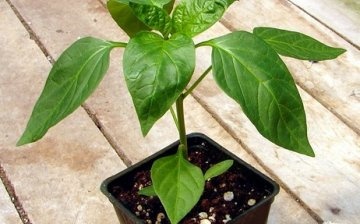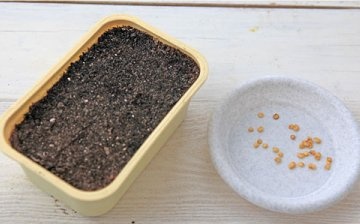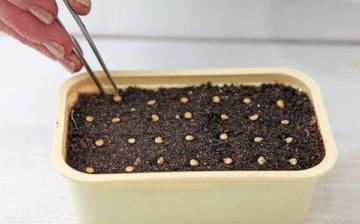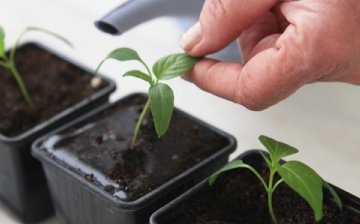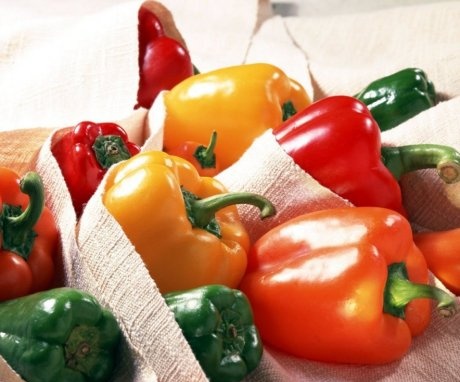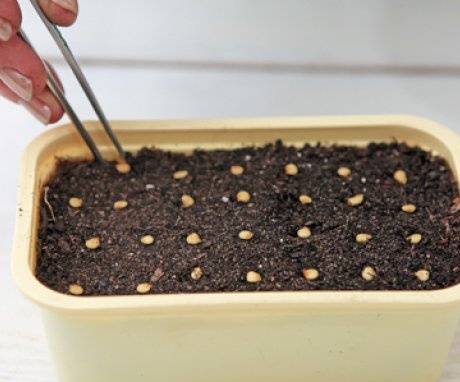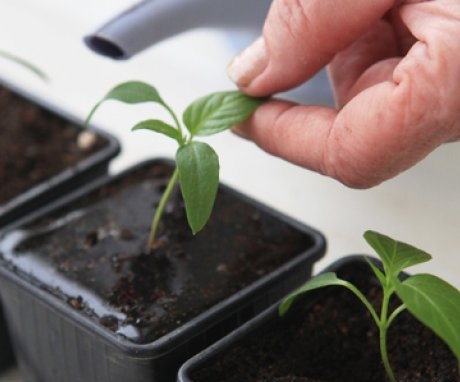Preparation and rules for planting pepper seeds for seedlings
Pepper - the plant is thermophilic, therefore, it is grown by seedlings in almost most of the territory of Russia. The quality of the seedlings, its viability depends on how the plant will take root in a permanent place, and, ultimately, what the harvest will be. Therefore, when sowing seeds and caring for seedlings, it is important to follow certain rules.
Content:
- The best peppers to grow
- Seed preparation and planting dates
- Soil preparation and seedling containers
- Planting secrets
- Care after landing
The best peppers to grow
When choosing peppers for cultivation, it is important to take into account several conditions. First of all, it is necessary to take into account the climate in the area of \ u200b \ u200bthe location of the garden plot. In addition, some varieties of pepper are unsuitable for canning, poor storage, etc. Some varieties are suitable for growing in greenhouses, while others grow well outdoors.
Early varieties of pepper:
- Tenderness
- Corvette
- Lemon Miracle
- Latino F1
- Prince Silver
The listed varieties are high-yielding, ripening period from 90 to 100 days. Tenderness, Latino F1 is grown only in greenhouses, Corvette is recommended to grow outdoors, and Lemon Miracle and Prince of Silver are suitable for growing both outdoors and indoors. The yield of these varieties of pepper is from 2 to 2.5 kg of fruits from one bush.
Mid-early varieties:
- Orange king
- Golden Taurus
- Red elephant
All these varieties of pepper are high-yielding, large-fruited, disease-resistant, with a ripening period of 110-115 days. The Orange Elephant is intended for cultivation in greenhouses, the Red Elephant is intended for outdoor cultivation, and the Golden Calf grows both indoors and outdoors.
Late-ripening high-yielding peppers with a ripening period of about 130 days:
- Paris F1
- Hottabych F1
- Cube-K
- Ruby
- Night
- Black cardinal
- Aristotle F1
- Capro F1
All of the above late-ripening varieties - hybridsresistant to diseases... Like all hybrids, they have increased vitality and good yields. In central Russia and in the north, late-ripening varieties are recommended to grow only in greenhouses, since the fruits do not have time to ripen before the onset of cold weather.
Seed preparation and planting dates
Seeds pepper on seedlings can be sown from early February to mid-April, depending on the time of planting seedlings in a greenhouse or open ground (in warm regions). In general, the time of sowing pepper seeds for seedlings depends on the qualities of the variety and on the growing method: with or without a pick.
Seeds of early-ripening pepper varieties are usually sown 60 days before transplanting into a greenhouse or open ground, late-ripening varieties - 70 days.
It is also important to note that seedlings that have been exposed to picking lags behind in development from unpicked plants by 8-10 days. Sowing dates also depend on local climatic conditions. If the seeds are sown too early, the seedlings overgrow, they begin to set fruit, which causes the depletion of the plants. Such seedlings take root less well in a permanent place and more often get sick.
Before sowing seeds, if there is no confidence in their quality, it is recommended to check for germination:
- Select 5-6 pepper seeds.
- Place them in a small cloth bag.
- Immerse a bag of seeds in water with a temperature of 25 degrees.
- After a day, take out and place in a shallow plate.
- Remove to a warm place.
- Make sure that the seed bag is constantly moist.
- After three days, plant in moist, warm soil.
- Wait for shoots.
- If seedlings do not appear, the seeds are not suitable for planting.
It is advisable to calibrate the seeds before sowing, removing the smallest and largest. Medium-sized seeds are considered to have the best qualities. It is also important to remove hollow seeds. Any seed material must be disinfected before planting to avoid diseases plants. The most elementary and affordable way of disinfection is with a 1-2% solution of potassium permanganate, or simply potassium permanganate: seeds placed in a bag or gauze are immersed for 25 minutes in a solution of potassium permanganate. Then it is washed well and dried slightly.
In order to get simultaneous, friendly shoots, it is recommended to place pepper seeds in a nutrient solution, which can be prepared in this way: take 1 teaspoon of any of the preparations for one liter of water:
- Nitrophoska
- Liquid sodium humate
- Wood ash
- Fertilizer "Ideal".
Seeds in bags made of cloth or gauze are dipped in any of the above solutions for one day, then taken out and placed in a container (for example, a saucer), slightly moistened with water, until the seeds germinate (peck). After this treatment, the seeds germinate on the fifth or sixth day.
A good result gives seed stratification:
- Put pepper seeds (after processing) for two days in the vegetable section of the refrigerator.
- Then keep it at a temperature of 18 degrees for a day.
- And again mark in the cold for two days.
- After this procedure, the seeds can be sown in seedling containers.
A specialized store sells pepper seeds already prepared for planting. Of course, they are much more expensive than ordinary ones, but such seed material can be immediately planted in the soil, because it has already been treated with various drugs: antifungal agents, microelements and growth stimulants. Typically, growers paint the treated seeds a bright color.
Soil preparation and seedling containers
Peppers need soil saturated with organic matter: when preparing the soil, it is advisable to take good compost, to which it is recommended to add a small amount of rotted manure. It is recommended to add additionally to the bucket of soil:
- Dolomite flour - 150 g.
- Nitroamofosk - 50 g.
Another way of preparing the soil: mix the soil from the garden (previously disinfected) in equal parts in peat soil. Add wood ash to the resulting mixture in a ratio of 1:15.
Do not use soil from the beds on which crops of the Solanaceae family were grown: such soil may contain pathogens of pepper diseases.
If the soil was stored in the cold, then a week before planting it must be placed in a warm room so that the earth warms up. For growing seedlings any deep container will do. Peppers do not grow very well in low pots. Initially, pepper can be sown in large containers, and after the seedlings grow up, the strongest shoots transplant in separate pots. Flower pots, peat pots, various plastic or wooden boxes are suitable as seedling containers. All this can be bought in specialized stores.
Planting secrets
In order for pepper seedlings to grow strong and hardy, when planting seeds, you need to follow some agrotechnical techniques:
- At the bottom of the containers for planting pepper, you need to put a drainage, on top of which you pour soil, water and, if necessary, add more.
- In the ground, make holes 1.5 cm deep (you can use a pencil), put the seeds, sprinkle with earth and water again.If the seeds are sown not in separate cups, but in a large container, the distance between the holes must be made at least 5 centimeters. Then it will be possible to do without picks.
- Containers with planted seeds must be covered with foil and removed to a warm place. This creates a greenhouse effect and the seeds germinate better.
- After the first shoots appear (even if not all the seeds have sprouted), the film is removed and the seedlings are placed in a bright place. Pepper is a light-loving plant, and it does not stretch out in the light as much as tomato.
- If the seedlings are on the south side, they do not need additional lighting. In any case, you need to remember that the seedlings should receive light within 12 hours a day. Lack of light causes the seedlings to stretch and bend. Plants may even stop growing and the roots may rot.
- Young pepper seedlings grow best at a temperature of about 25 degrees during the day and 20 degrees at night. At low temperatures, the pepper loses its leaves and may die.
Care after landing
When 3-4 leaves appear in pepper seedlings, the plants need more space for normal development. Therefore, they are transplanted (dived) into pots with a volume of at least 500 ml:
- Containers for picks fill with damp soil, leaving 4 cm on top.
- Make a depression, place the seedling.
- Carefully spread the roots, cover with soil to the height of half of the cotyledonous knee (located under the cotyledonous leaves).
Place the pots in a bright place at a distance sufficient so that the young peppers do not shade each other. If the seeds were planted immediately in separate pots, they do not dive, but transfer them into large containers. After such an operation, the roots are not injured, the pepper adapts easily and takes root well.
If the soil for planting was prepared with high quality (the composition was selected correctly, the necessary fertilizers), then the seedlings at first do not require top dressing... If you are not sure of the quality of the soil, for example, if it is purchased, then in the phase of two real leaves the plants are fed with a solution - take per liter of water: potassium sulfate and urea - 1 g each, double superphosphate - 4 g. black leg ", the plants should be planted in warm soil, and after picking around the seedling in a small layer (about half a centimeter), pour the calcined sand.
Pepper is picky about the air permeability of the soil, so regularly loosen the soil around the seedlings.
Watering seedlings are carried out with settled water at room temperature in the morning. It is important to ensure that the soil does not dry out or become waterlogged. Pepper responds well to organic feeding fertilizers... During the cultivation of seedlings, it can be fed 2 times with a solution of cow manure (in a ratio of 1:10) or dry chicken droppings (in a ratio of 1:20). Manure or droppings are poured with hot water and allowed to brew for 2 hours.
Useful video - Proper cultivation of pepper seedlings.
For feeding, you can also use complex mineral fertilizer... Pepper also reacts well to foliar feeding, for example, with the preparation of Kemira Kombi. Dissolve the fertilizer in warm water and spray the plants. It is better to do this in the morning, trying to get the solution on both sides of the leaves. In a properly developing, healthy pepper seedling, the upper leaves should be light green and the lower ones dark green. If this is not the case, it is possible that the plants lack nutrition, light, and the soil is too wet.
About two weeks before transplants to the greenhouse or to open beds pepper seedlings you need to start hardening. Take the seedlings to a cool place (for example, a balcony) with a temperature of 15-16 degrees, gradually increasing the hardening time and lowering the temperature to 12 degrees. Plants are ready for planting when they reach a height of 20 centimeters and have 7-10 true leaves.



